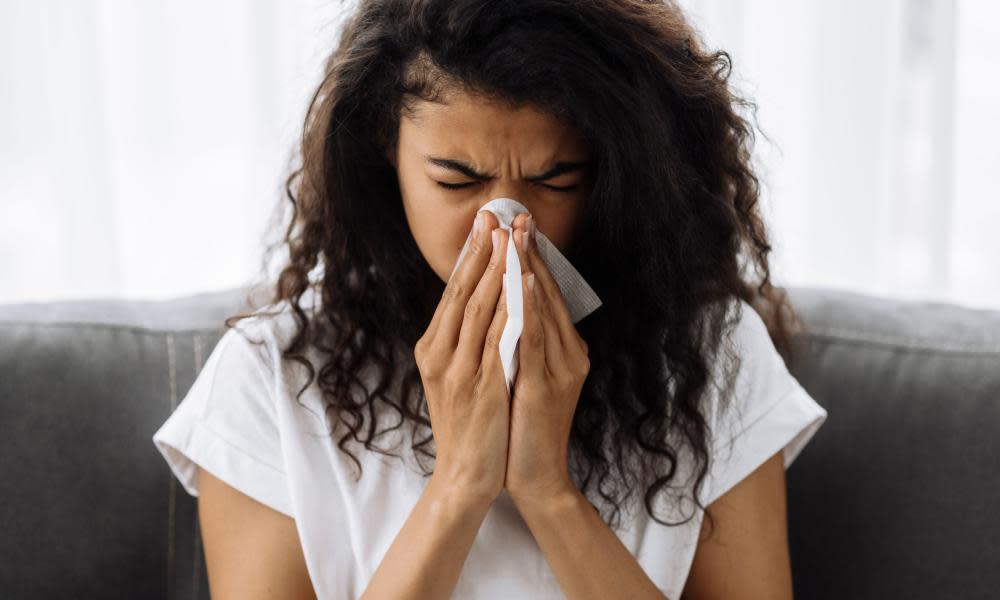Tested positive for Covid? Australian GPs on how to manage at home and when to go to hospital

Doctors explain what mild or moderate symptoms look like and when to seek medical assistance
As Covid case numbers in Australia hit record highs, so too have hospitalisation figures for the virus.
Dr Clare Skinner, the president of the Australasian College for Emergency Medicine, says presentations to emergency departments have increased in states affected by the Omicron wave.
“We’re seeing people who are [severely] sick from Covid … and then we are seeing people who present because they have tested positive to Covid and they want some assessment and treatment, but their symptoms are less severe than the other group.”
“The entire system is under strain – both the hospital system and primary care,” Skinner says.
Given the current burden on the healthcare system, what Covid symptoms are manageable at home, and when should you seek urgent medical assistance?
When should you go to hospital?
There are several guidelines and support services available to help people assess Covid symptoms and whether you can manage the condition from home. These include the coronavirus hotline on 1800 675 398, the federal government’s Health Direct guidelines, and the Royal Australian College of General Practitioners’ home care guide.
Related: Respirators or cloth? An Australian guide to face masks in the age of Omicron
“From my perspective, the worrying symptoms are things like severe difficulty breathing, chest pain, dizziness and not able to maintain fluid input,” Skinner says.
“So if you’ve got severe vomiting and diarrhoea and you’re not able to get fluids in, or you’re not passing urine as often as you normally would, then they are reasons to seek hospital-level care.”
Other red flags include worsening shortness of breath, blue lips or face, fainting or collapse, or a blood oxygen level of 92% or less as measured on a pulse oximeter, a device that indirectly measures oxygen saturation when worn over a finger.
“If people do have life-threatening or urgent symptoms, I implore them to seek care either through the emergency department or their GP. No one’s going to be judgmental with them about wasting our time,” Skinner says. “We will all do our best to provide the care they need.”
What are mild or moderate Covid symptoms?
Common Covid symptoms include fever, cough, headache, fatigue, loss of taste or smell, chills, runny nose, and mild shortness of breath.
Most people who are vaccinated will have mild to moderate symptoms if infected with Omicron, and won’t need to book an appointment with their GP, says Dr Karen Price, president of the Royal Australian College of General Practitioners.
“However, people who are high risk should contact their GP,” Price says. This includes people who are unvaccinated, aged over 65, pregnant, immunocompromised or Indigenous.
How to manage Covid at home
People who are managing their symptoms at home should consider buying a thermometer and have paracetamol or ibuprofen on hand – though pregnant women should avoid ibuprofen, Price says. “Some people self-managing at home may find it useful to record their symptoms daily, which can help show if a person’s condition is worsening.”
“Now is a good time to prepare a Covid-safe plan should you or a household member get Covid and be isolating for a period of time. This would include having ready access to the guidelines as well as isolation needs, food, fluids, pets and medications.
“An oximeter may be useful for people self-managing at home, but particularly for people who have risk factors for more severe disease, in collaboration with their medical team,” Price says. “For many with mild illness this will not be necessary.”
Skinner agrees: “Not everybody is going to need an oxygen saturation monitor. It’s for people who are at higher risk of deterioration with their Covid infection.”
People at high risk might be given a pulse oximeter by their GP, or can buy them online or at a pharmacy – but they should be approved by the Therapeutic Goods Administration.
Email: sign up for our daily morning briefing newsletter
App: download the free app and never miss the biggest stories, or get our weekend edition for a curated selection of the week's best stories
Social: follow us on YouTube, Facebook, Instagram, Twitter or TikTok
Podcast: listen to our daily episodes on Apple Podcasts, Spotify or search "Full Story" in your favourite app
Studies have also shown the devices may overestimate oxygen saturation readings in people with darker colour, with inaccuracies worse at lower oxygen levels.
“It’s best not to rely on smartphones or smartwatches that have a pulse oximeter function, as they are not accurate,” Price adds.
A useful guide for how someone’s respiratory function is tracking is whether they are breathless at rest, Skinner says. “When you have a viral infection, it’s usual to feel a little bit breathless when you do activities. But if you’re feeling unusually breathless doing activities, you’re breathless when you’re sitting still, or so breathless you can’t speak in sentences – they’re all signs that you need to seek medical care.”
Finally, Skinner encourages people with confirmed Covid to check their local health department website. “There’s a lot of misinformation circulating on social media,” she says. “Please find good sources of information.”

 Yahoo News
Yahoo News 
